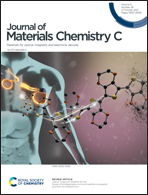Topochemical synthesis of perovskite-type CuNb2O6 with colossal dielectric constant†
Abstract
A novel A-site deficient quadruple perovskite (Pv) oxide, CuNb2O6, has been successfully obtained by a combination of high-pressure synthesis techniques and topochemical structural transformation. Post-annealing of high-pressure-synthesized Pv-CuNbO3 above 470 K at ambient pressure leads to the formation of Pv-CuNb2O6 due to the topochemical deinsertion of half of the copper ions, which is accompanied by changes in the valence state and coordination environment of the remaining copper ions from triangular coordinated Cu+ into square-planar coordinated Cu2+. A combined structural analysis using synchrotron X-ray and electron diffraction and optical second harmonic generation shows that Pv-CuNb2O6 crystallizes into a non-centrosymmetric cubic structure with the space group I23. Magnetic characterization reveals an antiferromagnetic order below 12 K. We find that this compound exhibits a colossal dielectric constant up to the order of 104. The topochemical cation deinsertion is also found in another high-pressure-synthesized Pv-CuTaO3, which produces cubic Pm![[3 with combining macron]](https://www.rsc.org/images/entities/char_0033_0304.gif) Pv-CuTa2O6. The present results are expected to provide a guideline for developing new functional materials.
Pv-CuTa2O6. The present results are expected to provide a guideline for developing new functional materials.



 Please wait while we load your content...
Please wait while we load your content...